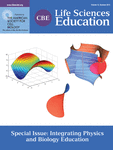Advantages and Challenges of Using Physics Curricula as a Model for Reforming an Undergraduate Biology Course
Abstract
We report on the development of a life sciences curriculum, targeted to undergraduate students, which was modeled after a commercially available physics curriculum and based on aspects of how people learn. Our paper describes the collaborative development process and necessary modifications required to apply a physics pedagogical model in a life sciences context. While some approaches were easily adapted, others provided significant challenges. Among these challenges were: representations of energy, introducing definitions, the placement of Scientists’ Ideas, and the replicability of data. In modifying the curriculum to address these challenges, we have come to see them as speaking to deeper differences between the disciplines, namely that introductory physics—for example, Newton's laws, magnetism, light—is a science of pairwise interaction, while introductory biology—for example, photosynthesis, evolution, cycling of matter in ecosystems—is a science of linked processes, and we suggest that this is how the two disciplines are presented in introductory classes. We illustrate this tension through an analysis of our adaptations of the physics curriculum for instruction on the cycling of matter and energy; we show that modifications of the physics curriculum to address the biological framework promotes strong gains in student understanding of these topics, as evidenced by analysis of student work.



